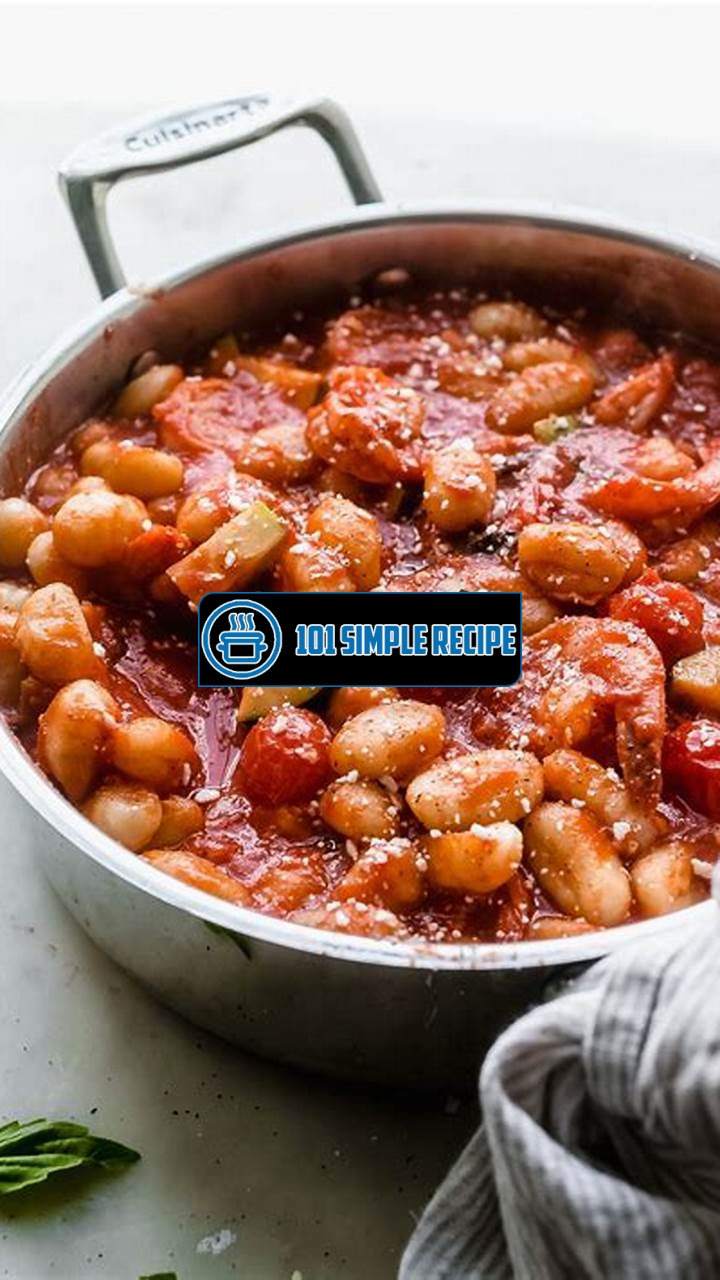Calling all pasta lovers! If you’re looking for a mouthwatering recipe that combines the perfect blend of flavors, then this

Shrimp Pomodoro recipe is sure to delight your taste buds.
The Origins of Shrimp Pomodoro
Discover the history and cultural significance of the beloved shrimp pomodoro dish.
The Italian Influence
Shrimp Pomodoro, a classic Italian pasta dish, has a rich and fascinating history. The word “pomodoro” itself means “tomato” in Italian, which highlights the importance of this ingredient in the recipe. Tomatoes were introduced to Italy in the 16th century and quickly became a staple in Italian cuisine. This led to the invention of numerous tomato-based sauces, including the famous pomodoro sauce.
The Italian influence on the shrimp pomodoro recipe cannot be overstated. Italians have a deep appreciation for simple yet flavorsome dishes that showcase the quality of fresh ingredients. The combination of succulent shrimp and tangy tomato sauce perfectly exemplifies this approach to cooking. Italians have mastered the art of combining a few key ingredients to create a dish that is greater than the sum of its parts, and shrimp pomodoro is a prime example of this culinary philosophy.
Throughout Italy, each region has its own unique take on shrimp pomodoro. From the coastal regions, where seafood is abundant, to the inland areas, where local produce takes center stage, the recipe varies subtly but significantly. The use of specific spices, herbs, and additional ingredients contribute to the regional variations and make each version of shrimp pomodoro a delightful surprise for the taste buds.
The Evolution of the Recipe
Over the centuries, the shrimp pomodoro recipe has evolved and adapted to suit changing tastes and preferences. Originally a humble dish made with basic ingredients, it has now become a popular choice in Italian-American cuisine and is often found on menus in Italian restaurants around the world.
While the core elements of shrimp, tomato sauce, and pasta remain constant, modern variations of the recipe often incorporate additional ingredients to enhance the flavor profile. These may include garlic, onions, chili flakes, and fresh herbs like basil or parsley. Some contemporary adaptations even feature a splash of white wine or a sprinkle of Parmesan cheese for added depth of flavor.
Regional Variations of Shrimp Pomodoro
As with any traditional dish, regional differences play a significant role in shaping the flavor of shrimp pomodoro. In coastal regions such as Sicily and Naples, seafood reigns supreme, and their versions of the dish often feature a generous amount of fresh shrimp or other shellfish.
In the northern regions of Italy, where tomatoes may not be as prevalent, the recipe might rely more on tomato paste or sun-dried tomatoes for that distinct tomato flavor. Additionally, regional variations may incorporate local ingredients like olives, capers, or anchovies to add a unique twist.
Overall, shrimp pomodoro is a beloved dish that has captivated the palates of pasta lovers worldwide. Its Italian origins, cultural significance, and regional variations all contribute to its enduring appeal. Whether enjoyed in a traditional Italian trattoria or recreated in your own kitchen, shrimp pomodoro is a culinary delight that showcases the beauty of simple, flavorsome ingredients.
For a refreshing drink to pair with your shrimp pomodoro, try this pink punch recipe.
Choosing the Perfect Shrimp
When it comes to preparing a delicious shrimp pomodoro recipe, selecting the ideal shrimp is crucial. The quality of the shrimp can greatly impact the taste and texture of your dish. Here, we will guide you on how to choose the perfect shrimp for your recipe, ensuring a mouthwatering dining experience.
Understanding Shrimp Grades
Before diving into the selection process, it’s essential to understand the different grades of shrimp available in the market. Shrimp grades are determined by their size and indicate how many shrimp are needed to make a pound. The smaller the number, the larger the shrimp.
Here are the common shrimp grades you’ll come across:
- Jumbo or Extra Large: These are the largest shrimp available, with approximately 10-12 shrimp per pound. They are perfect for showcasing their meaty texture and are ideal for presentation purposes.
- Large: Large shrimp come in at around 21-25 per pound. They are versatile and work well in various recipes, including shrimp pomodoro.
- Medium: With about 31-35 shrimp per pound, medium-sized shrimp are slightly smaller but still offer a good bite. They are suitable for dishes where shrimp is not the main focus.
- Small: Small shrimp, often labeled as salad shrimp, have around 41-50 shrimp per pound. They work well in salads, sandwiches, and appetizers, although might not be the best choice for shrimp pomodoro.
Fresh vs. Frozen Shrimp: Pros and Cons
When it comes to purchasing shrimp, you’ll usually find two options – fresh and frozen. Each has its pros and cons, and understanding them will help you make an informed decision.
Fresh Shrimp: Fresh shrimp are known for their superior taste and texture. They offer a delicate and sweet flavor that is hard to replicate with frozen alternatives. However, finding truly fresh shrimp can be a challenge, especially if you don’t live near the coast. Fresh shrimp also tend to be more expensive and have a shorter shelf life.
Frozen Shrimp: Frozen shrimp, on the other hand, are convenient and readily available year-round. They are often frozen immediately after being caught, preserving their freshness. Frozen shrimp are a cost-effective option, and you can easily stock up on them for future use. However, they may lose a bit of their natural flavor and texture during the freezing process.
Sustainable Shrimp Choices
As responsible consumers, it’s essential to consider sustainability when selecting shrimp for your pomodoro recipe. Overfishing and environmentally harmful practices can have severe consequences on marine ecosystems. By choosing sustainable shrimp options, you can support responsible fishing practices and protect our oceans.
Look for certifications such as the Marine Stewardship Council (MSC) or the Aquaculture Stewardship Council (ASC) when purchasing shrimp. These certifications ensure that the shrimp you are buying is sourced from sustainable and responsibly managed fisheries.
Don’t forget to ask your fishmonger or check the packaging for information about the shrimp’s origin and fishing or farming methods. By making conscious choices, you can enjoy your shrimp pomodoro guilt-free, knowing that you are contributing to the well-being of our planet.
Note: Always remember to thoroughly clean and devein your shrimp before cooking to remove any grit or impurities. Enjoy the succulent taste of the shrimp pomodoro recipe by using the perfect shrimp through careful selection and sustainable choices.
The Secret to Authentic Tomato Sauce
When it comes to creating the perfect tomato sauce for your shrimp pomodoro, there are a few key ingredients and techniques that can take your dish to the next level. In this section, we will uncover the secrets to achieving an authentic and flavorful tomato sauce.
Choosing the Right Tomatoes
The first step in making a delicious tomato sauce is selecting the right tomatoes. For the best flavor, opt for ripe, juicy, and flavorful tomatoes. The most commonly used varieties for tomato sauce are Roma tomatoes, San Marzano tomatoes, or vine-ripened tomatoes. These types of tomatoes have a rich taste and a good balance of sweetness and acidity, making them ideal for sauce preparations.
It is important to note that using fresh tomatoes instead of canned ones can elevate the taste of your tomato sauce to a whole new level.
The Importance of Garlic and Onions
No authentic tomato sauce is complete without the aromatic combination of garlic and onions. These two ingredients provide a savory base and add depth of flavor to your sauce. Garlic brings its distinct pungency and earthiness, while onions contribute sweetness and a hint of caramelization.
When using garlic, make sure to finely chop or mince it to release its full flavor. On the other hand, onions should be diced or thinly sliced for even cooking.
To enhance the taste, sauté the garlic and onions in olive oil until they turn golden brown. This process will not only soften the ingredients but also create a rich and fragrant foundation for your tomato sauce.
Spices and Herbs for Flavor Enhancement
To add an extra layer of flavor to your tomato sauce, incorporate a variety of spices and herbs. Some common choices include basil, oregano, thyme, and bay leaves. These herbs provide a fresh and aromatic profile that complements the sweetness of the tomatoes.
✨ Additionally, you can experiment with spices like red pepper flakes or black pepper to give your sauce a subtle kick. However, be mindful of the amounts used to avoid overpowering the delicate flavors of the other ingredients.
⏰ Simmering the sauce for at least 30 minutes allows all the flavors to meld together and develop a deeper complexity. This slow cooking process ensures that the tomatoes break down and release their natural sweetness and acidity, resulting in a mouthwatering tomato sauce.
By following these key techniques and incorporating the right ingredients, you can create an authentic tomato sauce that will elevate your shrimp pomodoro dish to new heights. Remember, the secret lies in the quality of your tomatoes, the flavors of garlic and onions, and the perfect balance of spices and herbs. So go ahead and give it a try – your taste buds will thank you!
Cooking the Shrimp to Perfection
When it comes to making a delicious shrimp pomodoro, cooking the shrimp to perfection is key. By mastering the art of cooking shrimp, you can ensure a tender and flavorful result that will elevate your pasta dish to new heights.
Marinating and Seasoning the Shrimp
Before you start cooking the shrimp, it’s important to marinate and season them properly to enhance their flavor. A simple marinade of olive oil, garlic, lemon juice, salt, and pepper can work wonders. Let the shrimp marinate for at least 30 minutes to allow the flavors to penetrate the meat.
Tip: You can experiment with different herbs and spices to create your own unique marinade.
Choosing the Right Cooking Method
There are several cooking methods you can choose from when preparing shrimp for your pomodoro. One popular method is sautéing, where you cook the shrimp quickly in a hot pan with some olive oil. This method gives the shrimp a nice caramelized crust while keeping the inside moist and tender.
Another option is grilling the shrimp, which adds a smoky flavor and beautiful grill marks to the meat. You can also broil them in the oven or even steam them for a lighter alternative.
Tip: Regardless of the cooking method you choose, make sure not to overcook the shrimp. They only need a few minutes to cook through, and overcooking will result in rubbery and tough shrimp.
Timing and Temperature for Optimal Doneness
To achieve optimal doneness, it’s crucial to get the timing and temperature right when cooking shrimp. The cooking time will vary depending on the size of the shrimp, but as a general rule, they should be opaque and firm to the touch when done.
The internal temperature of cooked shrimp should reach 145°F (63°C). Using a digital meat thermometer can help you ensure the shrimp are cooked to the perfect temperature.
Tip: If using frozen shrimp, make sure to thaw them completely before cooking to ensure even and thorough cooking.
By following these tips and techniques, you can cook shrimp to perfection for your shrimp pomodoro. Remember to marinate and season them well, choose the right cooking method, and pay attention to timing and temperature. With practice, you’ll be able to create a shrimp pomodoro that will impress any pasta lover.
To make a delicious shrimp pomodoro recipe, check out this article on 101 Simple Recipe.
Pairing and Serving Suggestions
When it comes to enjoying a delicious shrimp pomodoro pasta dish, there are several important factors to consider. One of the key components to a memorable dining experience is choosing the right wine to pair with your meal. Additionally, serving suggestions and garnishing tips can help elevate the overall presentation and taste of your shrimp pomodoro. Let’s explore these aspects in more detail.
Wine Pairings for Shrimp Pomodoro
Choosing the perfect wine to complement your shrimp pomodoro can enhance the flavors of the dish and elevate your dining experience. For seafood dishes like shrimp pomodoro, it is best to opt for a light-bodied white wine. A crisp and refreshing Sauvignon Blanc or a dry Chardonnay pair wonderfully with the tangy tomato sauce and succulent shrimp. These wines bring out the delicate flavors of the shrimp without overpowering the dish.
For those who prefer red wine, a light-bodied red such as a Pinot Noir can also be a great choice. The fruity notes in the wine balance the acidity of the tomato sauce and add depth to the overall taste.
Important: Remember to serve your wine chilled and in appropriate glassware to maximize the flavors and aromas.
Accompaniments and Side Dishes
A well-thought-out accompaniment or side dish can add another layer of flavor and texture to your shrimp pomodoro. Consider serving a simple green salad with a tangy vinaigrette alongside your pasta. The fresh greens provide a refreshing contrast to the rich flavors of the dish.
Another popular side dish option is garlic bread or a crusty baguette. The crisp texture and garlicky flavor pair perfectly with the savory shrimp and tomato sauce.
Pro tip: If you want to take your shrimp pomodoro to the next level, consider adding some freshly grated Parmesan cheese on top. The nutty and salty flavors of the cheese complement the sweet tomatoes and bring out the richness of the dish.
Presentation and Garnishing Tips
When it comes to presentation, a well-plated dish is always more appealing. Here are some tips to make your shrimp pomodoro visually enticing:
- Add a sprinkle of fresh herbs like basil or parsley on top of the pasta. This not only adds a pop of color but also enhances the aroma.
- Consider using a wide-rimmed pasta bowl or a plate with a colorful design to make the dish more visually appealing.
- You can also garnish the plate with a lemon wedge or thinly sliced lemon wheels. This adds a touch of brightness and can be squeezed over the pasta for an extra burst of citrus flavor.
- Lastly, drizzle a little extra-virgin olive oil over the pasta just before serving. This adds a glossy sheen to the dish and enhances the overall taste.
Remember: Presentation plays a crucial role in the overall dining experience, so take your time to plate the dish attractively.
With these wine pairing suggestions and serving tips, you can elevate your shrimp pomodoro pasta dish to a whole new level. Remember to experiment and personalize your meal according to your taste preferences. Enjoy the wonderful combination of flavors and textures!
If you’re looking for more simple and easy-to-make recipes, you might enjoy this link.
Frequently Asked Questions
Thank you for reading our article about the shrimp pomodoro recipe! We hope you found it helpful and inspiring. Here are some common questions that readers often ask about this delicious dish:
| No. | Questions | Answers |
|---|---|---|
| 1. | What is shrimp pomodoro? | Shrimp pomodoro is a classic Italian pasta dish that combines succulent shrimp with a rich and flavorful tomato sauce. It’s a perfect balance of seafood and pasta, creating a satisfying and tasty meal. |
| 2. | Can I use frozen shrimp for this recipe? | Yes, you can use frozen shrimp for this recipe. Just make sure to thaw them properly before cooking. It’s always best to use fresh shrimp if possible, but frozen shrimp can still deliver great taste and texture. |
| 3. | How spicy is shrimp pomodoro? | The level of spiciness in shrimp pomodoro can vary based on personal preference. This recipe typically includes a moderate amount of spice from red pepper flakes. However, you can adjust the spiciness by adding more or less red pepper flakes to suit your taste. |
| 4. | What type of pasta works best with shrimp pomodoro? | Shrimp pomodoro pairs well with a variety of pasta types, but spaghetti or linguine are the most commonly used. Their long, thin shape helps to hold the sauce and shrimp, providing the perfect texture and flavor combination. |
| 5. | Can I add other vegetables to the shrimp pomodoro? | Absolutely! While the traditional shrimp pomodoro recipe contains primarily shrimp and tomatoes, you can customize it by adding your favorite vegetables. Some popular additions include bell peppers, spinach, or mushrooms. Get creative with your ingredients to make the dish your own! |
| 6. | Can I make shrimp pomodoro ahead of time? | Yes, you can make the tomato sauce ahead of time and store it in the refrigerator for up to 3 days. When you’re ready to serve, simply cook the shrimp and pasta, then combine them with the sauce. This allows for convenient meal prep and ensures that you can enjoy shrimp pomodoro whenever you want! |
Thank You for Reading! Come Back for More Delightful Recipes
We hope you enjoyed learning about the shrimp pomodoro recipe. It’s a delightful dish that combines the succulence of shrimp with the richness of tomato sauce. Whether you’re a novice cook or an experienced chef, this recipe is sure to impress your taste buds. Remember to visit our website regularly for more mouthwatering recipes and culinary inspiration. Happy cooking!
Jump to Recipe
Shrimp Pomodoro Recipe

Learn how to make a delicious shrimp pomodoro recipe. This classic Italian dish combines succulent shrimp with a rich and flavorful tomato sauce. Perfect for a family dinner or entertaining guests.
- 1 pound shrimp (peeled and deveined)
- 8 ounces spaghetti
- 2 tablespoons olive oil
- 3 cloves garlic (minced)
- 1 can (14 ounces diced tomatoes)
- 1/4 teaspoon red pepper flakes
- Salt and pepper to taste
- Fresh basil leaves (for garnish)
- Bring a large pot of salted water to a boil. Cook the spaghetti according to package instructions until al dente. Drain and set aside.
- In a large skillet, heat the olive oil over medium heat. Add the minced garlic and sauté for 1 minute until fragrant. Add the shrimp and cook until pink and cooked through, about 2-3 minutes per side. Remove the shrimp from the skillet and set aside.
- In the same skillet, add the diced tomatoes (including the juice), red pepper flakes, salt, and pepper. Stir to combine and bring to a simmer. Cook for 5-7 minutes, until the sauce thickens slightly.
- Add the cooked shrimp back into the skillet with the tomato sauce. Stir to coat the shrimp with the sauce. Cook for an additional 2-3 minutes to heat the shrimp through.
- Divide the cooked spaghetti among plates. Top each plate with a generous portion of the shrimp and tomato sauce. Garnish with fresh basil leaves. Serve hot and enjoy!






